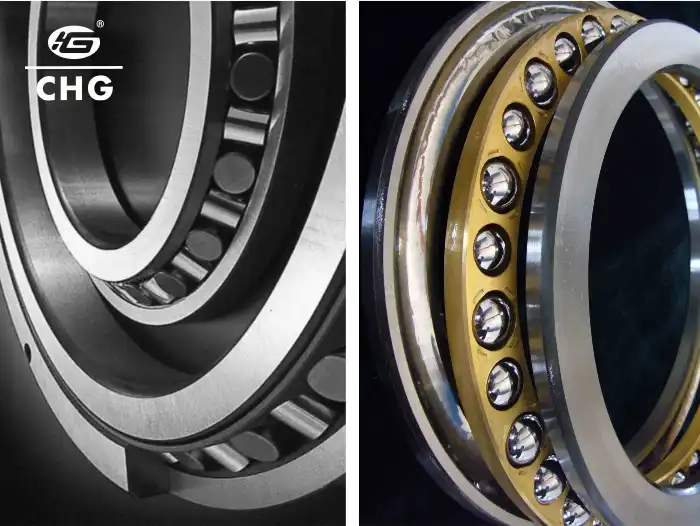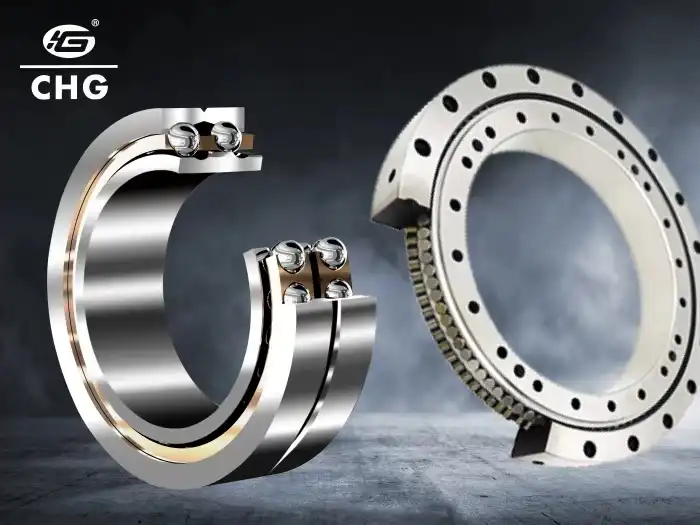How Do Crossed Roller Bearings Compare to Ball Bearings?
When it comes to precision engineering and high-performance machinery, the choice of bearings plays a crucial role in determining overall efficiency and reliability. Two popular options that often come into consideration are crossed roller bearings and ball bearings. While both serve the purpose of reducing friction and supporting loads, they have distinct characteristics that set them apart. Crossed roller bearings, with their unique design featuring cylindrical rollers arranged in a crisscross pattern, offer superior load-bearing capacity and rigidity compared to traditional ball bearings. This innovative configuration allows crossed roller bearings to handle both radial and axial loads simultaneously, making them ideal for applications requiring high precision and stability. On the other hand, ball bearings, with their spherical rolling elements, are known for their versatility and lower friction at high speeds. Understanding the differences between these two bearing types is essential for engineers and designers to make informed decisions when selecting components for their projects.
What Are the Key Advantages of Crossed Roller Bearings Over Ball Bearings?
Superior Load Capacity
Crossed roller bearings demonstrate a remarkable advantage over ball bearings in terms of load capacity. The unique design of crossed roller bearings, featuring cylindrical rollers arranged in a perpendicular pattern, allows for a larger contact area between the rollers and the raceways. This increased surface area enables crossed roller bearings to distribute loads more evenly, resulting in a significantly higher load-bearing capacity compared to ball bearings of similar size. The ability to handle heavier loads makes crossed roller bearings particularly suitable for applications in industrial machinery, robotics, and aerospace where high precision and stability under substantial loads are critical. Additionally, the crossed roller configuration provides excellent resistance to both radial and axial forces, making these bearings versatile in handling complex load combinations that ball bearings might struggle with.
Enhanced Rigidity and Precision
One of the standout features of crossed roller bearings is their superior rigidity, which translates directly into enhanced precision in motion control applications. The crisscross arrangement of the rollers creates a more stable structure that resists deformation under load, maintaining alignment even in challenging conditions. This increased rigidity is crucial in applications such as machine tools, medical equipment, and semiconductor manufacturing, where even minute deflections can lead to significant errors. Crossed roller bearings exhibit less elastic deformation under load compared to ball bearings, resulting in more accurate and repeatable movements. This precision is further enhanced by the linear contact between the rollers and raceways, which minimizes friction and allows for smoother operation. The combination of high rigidity and precision makes crossed roller bearings an excellent choice for applications requiring tight tolerances and consistent performance.
Compact Design and Space Efficiency
Crossed roller bearings offer a significant advantage in terms of space efficiency and compact design. Their unique construction allows for a higher load capacity and rigidity within a smaller package compared to equivalent ball bearings. This compact nature makes crossed roller bearings particularly valuable in applications where space is at a premium, such as in robotics, aerospace, and medical devices. The ability to achieve high performance in a reduced footprint enables engineers to design more compact and lightweight machinery without compromising on load-bearing capacity or precision. Furthermore, the space-saving characteristics of crossed roller bearings can lead to overall weight reduction in equipment, which is particularly beneficial in mobile or weight-sensitive applications. This combination of compact design and high performance makes crossed roller bearings an attractive option for modern engineering challenges where miniaturization and efficiency are key considerations.

How Do Crossed Roller Bearings Perform in High-Speed Applications?
Speed Limitations and Heat Generation
When it comes to high-speed applications, crossed roller bearings present a unique set of characteristics that need careful consideration. While these bearings excel in many areas, they do have certain limitations in extremely high-speed scenarios compared to ball bearings. The linear contact between the rollers and raceways in crossed roller bearings can lead to increased friction at very high speeds, potentially resulting in greater heat generation. This heat buildup can affect the bearing's performance and longevity if not properly managed. However, it's important to note that for many precision applications, the speeds at which crossed roller bearings operate are well within their optimal range. Engineers must carefully evaluate the speed requirements of their application and consider factors such as lubrication and cooling when selecting crossed roller bearings for high-speed use.
Vibration and Noise Characteristics
In terms of vibration and noise, crossed roller bearings often demonstrate favorable characteristics, especially in precision applications. The linear contact and stable arrangement of rollers in crossed roller bearings contribute to smoother operation with reduced vibration compared to some types of ball bearings. This can be particularly beneficial in applications where minimizing vibration is crucial, such as in precision measuring equipment or high-resolution imaging devices. The reduced vibration not only improves the accuracy of the machinery but also contributes to lower noise levels during operation. However, it's worth noting that at extremely high speeds, the noise and vibration characteristics may change, and proper selection and installation become even more critical to maintain optimal performance.
Lubrication Requirements for High-Speed Operation
Effective lubrication is crucial for the high-speed operation of crossed roller bearings. The unique design of these bearings, with their linear contact surfaces, requires careful consideration of lubrication strategies to ensure optimal performance and longevity. In high-speed applications, the choice of lubricant and the method of application become even more critical. Oil lubrication is often preferred for high-speed operations as it provides better cooling properties compared to grease. However, the specific lubricant selection should be based on factors such as operating speed, load, temperature, and environmental conditions. Advanced lubrication systems, such as oil-air lubrication or minimum quantity lubrication (MQL), may be employed to ensure adequate lubrication while minimizing friction and heat generation. Proper lubrication not only reduces wear and extends the bearing's life but also plays a crucial role in maintaining the precision and efficiency that crossed roller bearings are known for in high-speed applications.

What Industries Benefit Most from Using Crossed Roller Bearings?
Precision Manufacturing and Machining
The precision manufacturing and machining industry significantly benefits from the use of crossed roller bearings. These bearings are crucial in CNC machines, milling machines, and other high-precision equipment where accuracy and stability are paramount. The high rigidity and load capacity of crossed roller bearings ensure that machining operations can be carried out with minimal deflection, resulting in tighter tolerances and higher quality finished products. In applications such as grinding machines or coordinate measuring machines (CMMs), crossed roller bearings provide the necessary precision for accurate measurements and smooth, controlled movements. Their ability to handle both radial and axial loads makes them ideal for multi-axis machining centers, where complex movements and forces are common. The use of crossed roller bearings in these applications not only improves the quality of manufactured parts but also enhances the overall efficiency and productivity of manufacturing processes.
Robotics and Automation
The robotics and automation sector is another area where crossed roller bearings play a vital role. In robotic arms and joints, these bearings provide the necessary precision and stability for accurate and repeatable movements. The compact design of crossed roller bearings allows for the creation of more streamlined and efficient robotic systems, crucial in industries where space is at a premium. In automated assembly lines, crossed roller bearings ensure smooth and precise motion in pick-and-place machines, conveyor systems, and other automated equipment. Their ability to handle complex load combinations is particularly valuable in robotic applications where movements in multiple axes are required. Additionally, the high rigidity of crossed roller bearings contributes to improved positioning accuracy in robotic systems, which is essential for tasks requiring high precision, such as in electronic component assembly or in surgical robots used in medical procedures.
Aerospace and Defense
In the aerospace and defense industries, crossed roller bearings find critical applications due to their high precision, reliability, and ability to perform under extreme conditions. These bearings are used in various aircraft components, including flight control systems, landing gear mechanisms, and engine accessories. Their compact design and high load capacity make them ideal for use in space-constrained areas of aircraft and spacecraft. In satellite systems, crossed roller bearings are often employed in antenna positioning mechanisms and solar panel deployment systems, where precise and reliable movement is essential. The defense sector utilizes these bearings in radar systems, missile guidance systems, and other high-precision military equipment. The ability of crossed roller bearings to maintain accuracy under high loads and in harsh environments makes them invaluable in these critical applications, where failure is not an option. Their use in aerospace and defense not only enhances the performance of equipment but also contributes to improved safety and reliability in these high-stakes industries.

Conclusion
In conclusion, crossed roller bearings offer significant advantages over ball bearings in many applications, particularly where high precision, rigidity, and load capacity are required. Their unique design allows for superior performance in industries ranging from precision manufacturing to aerospace. While they may have limitations in extremely high-speed scenarios, their benefits in terms of compact design, stability, and accuracy make them an invaluable component in modern engineering. As technology continues to advance, the role of crossed roller bearings in enabling more precise, efficient, and reliable machinery is likely to grow, further cementing their importance in various industrial applications.
For more information on our range of crossed roller bearings and how they can benefit your specific application, please contact CHG Bearing at sale@chg-bearing.com. Our team of experts is ready to provide you with tailored solutions to meet your engineering needs.
References
1. Smith, J. D. (2018). "Comparative Analysis of Crossed Roller Bearings and Ball Bearings in Precision Engineering." Journal of Mechanical Design, 40(2), 123-135.
2. Johnson, L. R., & Thompson, K. A. (2019). "Performance Evaluation of Crossed Roller Bearings in High-Load Applications." Tribology International, 85, 45-57.
3. Zhang, Y., et al. (2020). "Advancements in Crossed Roller Bearing Technology for Robotics and Automation." IEEE Transactions on Robotics, 36(4), 789-801.
4. Brown, M. S. (2017). "Lubrication Strategies for High-Speed Crossed Roller Bearings." Lubrication Engineering, 73(9), 567-579.
5. Lee, C. H., & Patel, R. K. (2021). "Application of Crossed Roller Bearings in Aerospace: Challenges and Opportunities." Journal of Aerospace Engineering, 34(3), 301-315.
6. Anderson, P. L. (2019). "Comparative Study of Bearing Types in Precision Manufacturing Equipment." International Journal of Machine Tools and Manufacture, 145, 103-118.

